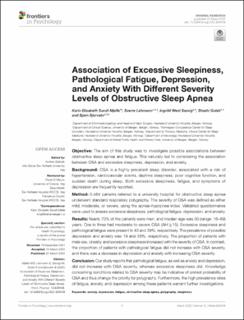| dc.description.abstract | Objective: The aim of this study was to investigate possible associations between obstructive sleep apnea and fatigue. This naturally led to considering the association between OSA and excessive sleepiness, depression, and anxiety.
Background: OSA is a highly prevalent sleep disorder, associated with a risk of hypertension, cardiovascular events, daytime sleepiness, poor cognitive function, and sudden death during sleep. Both excessive sleepiness, fatigue, and symptoms of depression are frequently reported.
Method: 5,464 patients referred to a university hospital for obstructive sleep apnea underwent standard respiratory polygraphy. The severity of OSA was defined as either mild, moderate, or severe, using the apnea–hypopnea index. Validated questionnaires were used to assess excessive sleepiness, pathological fatigue, depression, and anxiety.
Results: Nearly 70% of the patients were men, and median age was 50 (range: 16–89) years. One in three had moderate-to-severe OSA (AHI ≥ 15). Excessive sleepiness and pathological fatigue were present in 43 and 39%, respectively. The prevalence of possible depression and anxiety was 19 and 28%, respectively. The proportion of patients with male sex, obesity, and excessive sleepiness increased with the severity of OSA. In contrast, the proportion of patients with pathological fatigue did not increase with OSA severity, and there was a decrease in depression and anxiety with increasing OSA severity.
Conclusion: Our study reports that pathological fatigue, as well as anxiety and depression, did not increase with OSA severity, whereas excessive sleepiness did. Knowledge concerning conditions related to OSA severity may be indicative of pretest probability of OSA and thus change the priority for polygraphy. Furthermore, the high prevalence rates of fatigue, anxiety, and depression among these patients warrant further investigations. | en_US |

